Excerpts from Jim Conrad's
Naturalist Newsletter
entry dated March 22, 2022, issued from near Tequisquiapan, elevation about 1,900m (6200 ft), N20.565°, W99.890°, Querétaro state, MÉXICO (~N20.55°, ~W99.89°) Nowadays as the late dry-season landscape speaks mostly in tones of sun-bleached gray and brown, in an open, scrubby area occasionally nibbled by passing cows, goats and sheep, the above widely spreading, thorny tree is producing orangish, spherical flowering heads, as seen below: Below is a closer look at some heads, as well as this year's newly emerging, twice-compound leaves. When you see flowering heads like that mostly consisting of long, slender stamens radiating from tiny corollas almost hidden by the stamens, and with such twice-divided, feathery leaves, you can be fairly sure that you're dealing with one of the Bean Family's three big subfamilies, the Mimosoideae, in which you find many species of mimosas and acacias, and a host of smaller plant groups. Our arid upland location is especially rich in members of this subfamily. In our general area, known as the Bajío, the subfamily is represented by 18 genera with 67 species. Sometimes figuring out which species is which can be a challenge. A good place to start when identifying members of the Mimosa Subfamily is to count the number of stamens. Flowers of mesquites and the big genus Mimosa bear up to ten stamens; the numerous acacias and other lesser-known members of the subfamily have ten or more stamens. Below you can see that these flowers produce more than ten stamens per corolla: Seeing more than 10 stamens, we know we don't have a mimosa or mesquite, and that there's a strong chance it's an acacia, simply because acacias are such a big group. There are around 1400 species of them, using the broad sense of what an acacia is. Also, our tree's low, spiny, broadly spreading form looks just like acacia species emblematic of African and Australian savannas. However, several other similar-looking, none-acacia tree kinds occur in our area, so to know what's at hand one just has to take a closer look and "do the botany." At least in our area, an important feature distinguishing acacias from nearly all other members of the Mimosa Subfamily whose flowers produce more than ten stamens is that the stamens are not fused at their bases into a tube of various lengths. With a hand lens I convinced myself that these flowers' stamens were not fused into a tube of any length. Below, you see the fieldmark separating acacias from all remaining members of the Mimosa Subfamily in our area: Where leaves attach to the stem, there's a pair of broad-based spines called stipular spines, and in this case the spines are as hairy as the hairy stem. Moreover, now that we know we have an acacia, the dense hairiness helps us figure out which acacia we have. In the picture, the green items are a future leaf with its many leaflets. Probably the brown hairs served earlier to protect the fragile, immature leaf. Another field mark worth noticing is shown below. The leaf's petiole at the picture's top right as well as leaflet undersurfaces are hairy, though once the leaflets open it appears that their top surfaces will be hairless. Also, note the tiny, pink, doughnut-shaped item atop the petiole, at the point where the leaf's first subdivision take place. That's a gland, which acacias generally have, though the gland's position on the leaf's central stem, or rachis, changes from species to species. Thanks to detailed descriptions and identification keys in the wonderful Fora del Bajío -- the Bajío being our part of upland, arid central Mexico -- the above features lead us to the Twisted Acacia, VACHELLIA (ACACIA) SCHAFFNERI. But before continuing, that name Vachellia must be dealt with. The Fora del Bajío treatment, published in 2007, names our tree Acacia schaffneri, not recognizing the genus Vachellia. The Flora, using its older interpretation of what an acacia is, further tells us that about 1400 acacia species exist, of which most are native to Australia, and that about 160 acacia species occur in the Americas. Mexico is home to about 73 species, and in our Bajío area 15 have been documented. However, these are days when taxonomy is governed by what the genes say, and genetic sequencing of various species from all over the world reveals that what we've always called acacias are not just one thing -- not all real acacias. In 2005 the International Code of Nomenclature decreed that Acacia had to be split up. Since then there's been enormous debate among the planet's botanists about who will get to keep the acacia name, with lots of species being shifted about. Now in 2022, often grudgingly, most but not all American botanists say that most American trees traditionally regarded as acacias actually belong to the genus Vachellia. The tree we're profiling here is Vachellia schaffneri, then, though in informal English we can still call it an acacia.
Our Twisted Acacia bears an English name because it's commonly distributed from southern Texas south throughout most the Mexican arid uplands, as far south as Oaxaca. Throughout its Mexican area, people tend to lump it with the abundant, similarly orange-flowered, similarly spiny and feathery-leafed Huisache, or Sweet Acacia, Vachellia farnesiana. One way to distinguish Twisted Acacia from Huisache/Sweet Acacia is by the location of its gland. Glands on Sweet Acacia's leaves lie on the rachis's upper part, on or near where the outermost first subdivision takes place, not at the lowest, as with Twisted Acacia. From other similar species, Twisted Acacia is distinguished by its leaves' hairiness. Twisted Acacia is used in this area as firewood.
TWISTED ACACIA FLOWERING

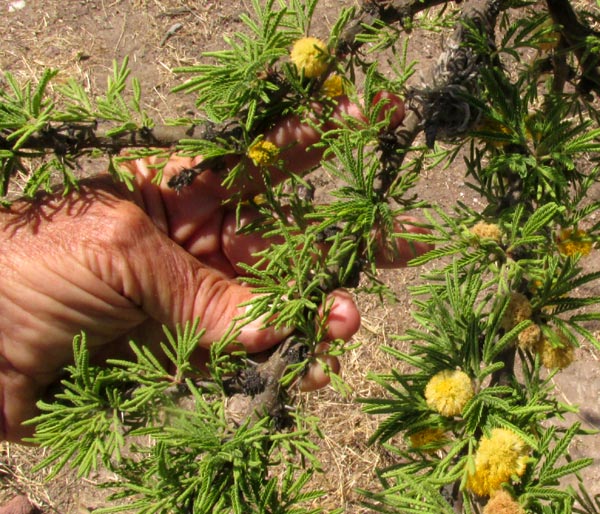
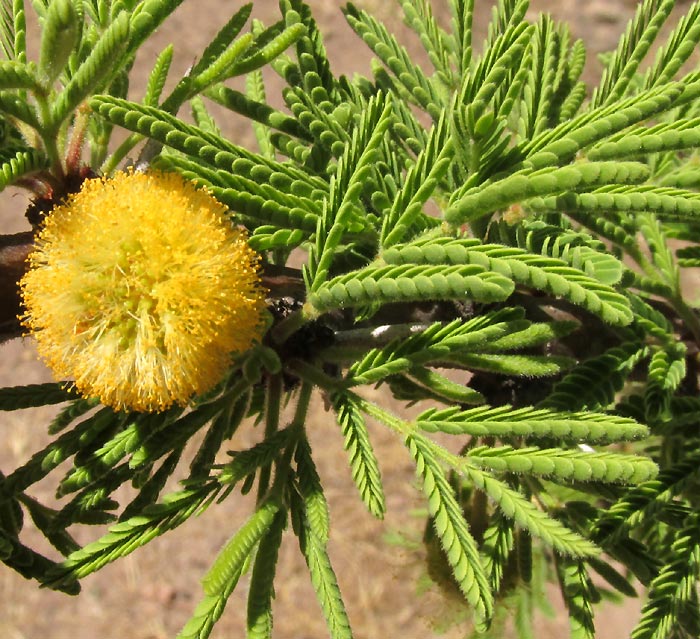
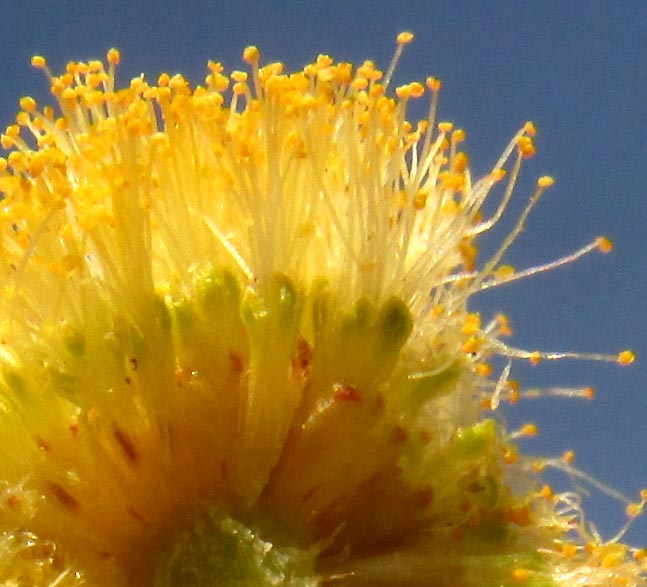
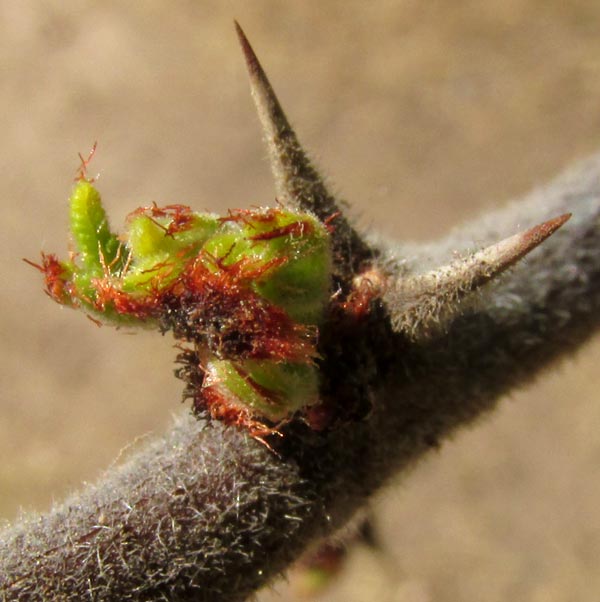
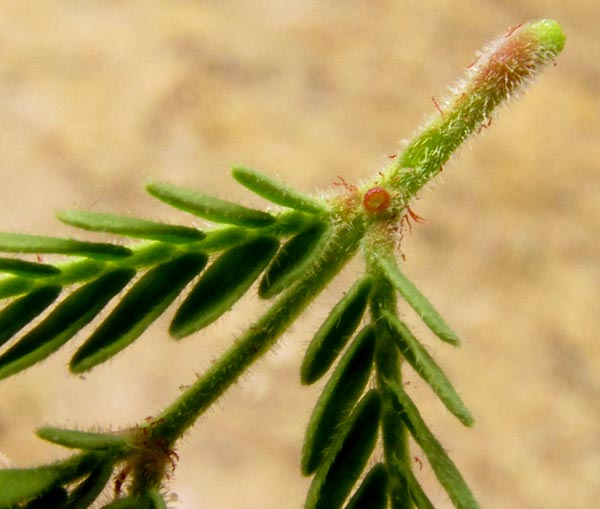
entry dated August 1, 2022, issued from near Tequisquiapan, elevation about 1,900m (6200 ft), ~N20.57°, ~ W99.89°, Querétaro state, MÉXICO
TWISTED ACACIA FRUITING
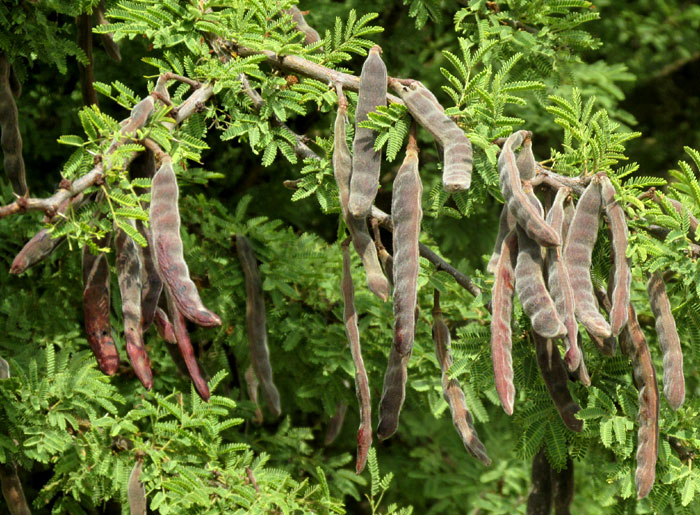
Nowadays the Twisted Acacia trees loaded with legumes, as shown above. I'd expected them to be twisted, but they're not. Maybe it's the wood that's twisted, and the above tree is in fact somewhat gnarly. The pods are hard, but I understand that goats and sheep eat them.